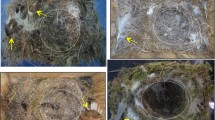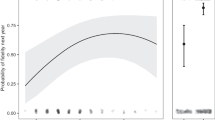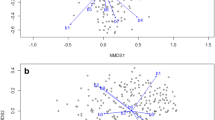Abstract
The underlying mechanisms connecting correlated behaviors in wild populations remain largely unknown. Food-caching behavior is a prime example of an adaptive, compulsive-like behavior with a strong underlying innate drive—it starts after early development and is critical for survival—and individuals of some species rigorously and continuously cache up to tens of thousands of individual food items each season. Another behavior whose base processes may share similar underlying innate drive is nest building, as it involves repeatedly bringing material to the nest site often in a fixed pattern. There are various hypotheses attempting to explain inter- and intra-specific variation in nest characteristics, traditionally considering fitness-related consequences of such variation. Apparent non-functional nest variation remains largely unexplored but may have an association with other innately driven behaviors unrelated to nest building but potentially associated via a shared mechanism, such as food caching. Here, we show that individual variation in food hoarding is associated with differences in nest size in mountain chickadees (Poecile gambeli): individuals that cache more food also build bigger nests. Both behaviors are highly repeatable within individual females, but variation in nest size does not seem to have fitness consequences in our system. This finding suggests a possible connection in which the properties of one adaptive behavior may spillover and influence the outcome of another more neutral behavior, likely controlled by the same general underlying mechanism.
Significance statement
Food storing and some aspects of nest-building behavior are highly repetitive actions that appear compulsive-like in nature. We show that these two behaviors are correlated in a wild avian food-caching species, the mountain chickadee: individual females in a wild population that cache more food also build larger nests. Both behaviors were highly repeatable within individual birds across time and climatic condition. Food storing is highly adaptive in chickadees, whereas nest size appears to have little effect on offspring fitness in this system. Therefore, our data suggest that these two compulsive-like behaviors may be controlled by the same general mechanism and the strong innate drive of adaptive food caching may spillover to potentially impact neutral nest building.




Similar content being viewed by others
Data availability
All data analyzed for this study are included in this article and its corresponding supplementary materials.
References
Anholt RRH (2020) Evolution of epistatic networks and the genetic basis of innate behaviors. Trends Genet 36:24–29
Bell AM, Hankison SJ, Laskowski KL (2009) The repeatability of behaviour: a meta-analysis. Anim Behav 77:771–783
Bouvier JC, Muller I, Génard M, Lescourret F, Lavigne C (2014) Nest-site and landscape characteristics affect the distribution of breeding pairs of European rollers Coracias garullus in an agricultural area of southeastern France. Acta Ornithol 49:23
Breen AJ, Guillette LM, Healy SD (2016) What can nest-building birds teach us? Compar Cogn Behav Rev 11:83–102
Britt J, Deeming DC (2011) First-egg date and air temperature affect nest construction in Blue Tits Cyanistes caeruleus, but not in great tits Parus major. Bird Study 58:78–89
Bugnyar T, Stöwe M, Heinrich B (2007) The ontogeny of caching in ravens, Corvus corax. Anim Behav 74:757–767
Camacho-Alpízar A, Eckersley T, Lambert CT, Balasubramanian G, Guillette LM (2021) If it ain’t broke don’t fix it: breeding success affects nest-building decisions. Behav Process 184:104336.
Clayton NS (1992) The ontogeny of food-storing and retrieval in marsh tits. Behaviour 122:11–25
Clayton NS, Dickinson A (1999) Motivational control of caching behaviour in the scrub jay, Aphelocoma coerulescens. Anim Behav 57:435–444
Clayton NS, Griffiths D, Bennett ATD (1994) Storage of stones by jays Garrulus glandarius. Ibis 136:331–334
Clayton NS, Dally J, Gilbert J, Dickinson A (2005) Food caching by western scrub-jays (Aphelocoma californica) is sensitive to the conditions at recovery. J Exp Psychol Anim B 31:115–124
Crossman CA, Rohwer VG, Martin PR (2011) Variation in the structure of bird nests between northern Manitoba and southeastern Ontario. PLoS ONE 6:e19086.
Croston R, Kozlovsky DY, Branch CL, Parchman TL, Bridge ES, Pravosudov VV (2016) Individual variation in spatial memory performance in wild mountain chickadees from different elevations. Anim Behav 111:225–234
Dall SRX, Bell AM, Bolnick DI, Ratnieks FLW (2012) An evolutionary ecology of individual differences. Ecol Lett 15:1189–1198
de Kort SR, Correia SPC, Alexis DM, Dickinson A, Clayton NS (2007) The control of food-caching behavior by western scrub-jays (Aphelocoma californica). J Exp Psychol Anim B 33:361–370
Deeming DC, Mainwaring MC, Hartley IR, Reynolds SJ (2012) Local temperature and not latitude determines the design of blue tit and great tit nests. Avian Biol Res 5:203–208
Derbyshire R, Norris DR, Hobson KA, Strickland D (2019) Isotopic spiking and food dye experiments provide evidence that nestling Canada Jays (Perisoreus canadensis) receive cached food from their parents. Can J Zool 97:368–375
Eilam D, Zor R, Szechtman H, Hermesh H (2006) Rituals, stereotypy and compulsive behavior in animals and humans. Neurosci Biobehav R 30:456–471
Finley J, Ireton D, Schleidt WM, Thompson TA (1983) A new look at the features of mallard courtship displays. Anim Behav 31:348–354
Freas CA, LaDage LD, Roth TC, Pravosudov VV (2012) Elevation-related differences in memory and the hippocampus in mountain chickadees, Poecile gambeli. Anim Behav 84:121–127
Fresneau N, Kluen E, Brommer JE (2014) A sex-specific behavioral syndrome in a wild passerine. Behav Ecol 25:359–367
Greene-Schloesser DM, Van der Zee EA, Sheppard DK, Castillo MR, Gregg KA, Burrow T, Foltz H, Slater M, Bult-Ito A (2011) Predictive validity of a non-induced mouse model of compulsive-like behavior. Behav Brain Res 221:55–62
Guillette LM, Healy SD (2015) Nest building, the forgotten behaviour. Curr Opin Behav Sci 6:90–96
Haftorn S (1992) Ontogeny of food storing in titmice Parus spp. Ibis 134:69–71
Hall ZJ, Meddle SL, Healy SD (2015) From neurons to nests: nest-building behaviour as a model in behavioural and comparative neuroscience. J Ornithol 156:133–143
Henschel JR, Skinner JD (1991) Territorial behaviour by a clan of spotted hyaenas Crocuta crocuta. Ethology 88:223–235
Johnson JC (2013) Debates: challenging a recent challenge to the aggressive spillover hypothesis. Ethology 119:811–813
Johnson JC, Sih A (2005) Precopulatory sexual cannibalism in fishing spiders (Dolomedes triton): a role for behavioral syndromes. Behav Ecol Sociobiol 58:390–396
Kilham L (1963) Food storing of red-bellied woodpeckers. Wilson Bull 75:227–234
Kozlovsky DY, Branch CL, Pitera AM, Pravosudov VV (2018) Fluctuations in annual climatic extremes are associated with reproductive variation in resident mountain chickadees. R Soc Open Sci 5:171604.
Lee CT (1973) Genetic analyses of nest-building behavior in laboratory mice (Mus musculus). Behav Genet 3:247–256
Lucas JR, Peterson LJ, Boudinier RL (1993) The effects of time constraints and changes in body mass and satiation on the simultaneous expression of caching and diet-choice decisions. Anim Behav 45:639–658
Lucas JR, Pravosudov VV, Zielinski DL (2001) A reevaluation of the logic of pilferage effects, predation risk, and environmental variability on avian energy regulation: the critical role of time budgets. Behav Ecol 12:246–260
Mainwaring MC, Hartley IR, Lambrechts MM, Deeming DC (2014) The design and function of birds’ nests. Ecol Evol 4:3909–3928
Mitra S, Bult-Ito A (2021) Bidirectional behavioral selection in mice: a novel pre-clinical approach to examining compulsivity. Front Psychiatry 12:716619.
Pravosudov VV (1985) Search for and storage off food by Parus cinctus lapponicus and P. borealis (Paridae). Zool Zh 64:1036–1043
Pravosudov VV (2006) On seasonality in food-storing behaviour in parids: do we know the whole story? Anim Behav 6:1455–1460
Pravosudov VV (2008) Mountain chickadees discriminate between potential cache pilferers and non-pilferers. Proc R Soc Lond B 275:55–61
Pravosudov VV, Clayton NS (2002) A test of the adaptive specialization hypothesis: population differences in caching, memory, and the hippocampus in black-capped chickadees (Poecile atricapilla). Behav Neurol 116:515–522
Pravosudov VV, Roth TC II (2013) Cognitive ecology of food hoarding: the evolution of spatial memory and the hippocampus. Annu Rev Ecol Evol S 44:173–193
Pravosudov VV, Roth TC, LaDage LD (2010) Chickadees are selfish group members when it comes to food caching. Anim Behav 80(2):175–180
R Core Team (2020) R: A language and environment for statistical computing. R Foundation for Statistical Computing, Vienna, Austria, http://www.R-project.org
Roth TC, LaDage LD, Pravosudov VV (2010) Learning capabilities enhanced in harsh environments: a common garden approach. Proc R Soc Lond B 277:3187–3193
Roth TC, LaDage LD, Freas CA, Pravosudov VV (2012) Variation in memory and the hippocampus across populations from different climates: a common garden approach. Proc R Soc Lond B 279:402–410
Sih A, Bell A, Johnson JC (2004a) Behavioral syndromes: an ecological and evolutionary overview. Trends Ecol Evol 19:372–378
Sih A, Bell A, Johnson J, Ziemba R (2004b) Behavioral syndromes: an integrative overview. Q Rev Biol 79:241–277
Silk MJ, Harrison XA, Hodgson DJ (2020) Perils and pitfalls of mixed-effects regression models in biology. PeerJ 8:e9522.
Sofaer HR, Nagle L, Sillett TS, Yoon J, Ghalambor CK (2020) The importance of nighttime length to latitudinal variation in avian incubation attentiveness. J Avian Biol 2020:e02319
Sonnenberg BR, Branch CL, Pitera AM, Bridge E, Pravosudov VV (2019) Natural selection and spatial cognition in wild food-caching mountain chickadees. Curr Biol 29:670–676
Sonnenberg BR, Branch CL, Benedict LM, Pitera AM, Pravosudov VV (2020) Nest construction, ambient temperature and reproductive success in a cavity-nesting bird. Anim Behav 165:43–58
Stoffel MA, Nakagawa S, Schielzeth H (2017) RptR: Repeatability estimation and variance decomposition by generalized linear mixed-effects models. Methods Ecol Evol 8:1639–1644
Suddendorf T, Busby J (2003) Mental time travel in animals? Trends Cogn Sci 7:391–396
Suddendorf T, Corballis MC (2007) The evolution of foresight: what is mental time travel, and is it unique to humans? Behav Brain Sci 30:299–313
Sutton AO, Strickland D, Freeman NE et al (2019) Autumn freeze-thaw events carry over to depress late-winter reproductive performance in Canada jays. Royal Society Open Science 6:181754
Szechtman H, Ahmari SE, Beninger RJ, Eilam D, Harvey BH, Edemann-Callesen H, Winter C (2017) Obsessive-compulsive disorder: insights from animal models. Neurosci Biobehav R 76:254–279
Uher J (2011) Individual behavioral phenotypes: an integrative meta-theoretical framework. why “behavioral syndromes” are not analogs of “personality.” Dev Psychobiol 53:521–548
van Oers K, Drent PJ, de Goede P, van Noordwijk AJ (2004) Realized heritability and repeatability of risk-taking behaviour in relation to avian personalities. Proc R Soc Lond B 271:65–73
Vander Wall SB (1990) Food hoarding in animals. University of Chicago Press, Chicago
Walsh PT, Hansell M, Borello WD, Healy SD (2010) Repeatability of nest morphology in African weaver birds. Biol Lett 6:149–151
Walsh PT, Hansell M, Borello WD, Healy SD (2011) Individuality in nest building: do Southern masked weaver (Ploceus velatus) males vary in their nest-building behaviour? Behav Process 88:1–6
Walsh PT, Hansell M, Borello WD, Healy SD (2013) Are elaborate bird nests built using simple rules? Avian Biol Res 6:157–162
Whitehouse CM, Lewis MH (2015) Repetitive behavior in neurodevelopmental disorders: clinical and translational Findings. Behav Anal 38:163–178
Wickham H (2016) ggplot2: elegant graphics for data analysis. Springer-Verlag, New York.
Wolf M, Weissing FJ (2012) Animal personalities: consequences for ecology and evolution. Trends Ecol Evol 27:452–461
Zuur AF, Ieno EN (2016) A protocol for conducting and presenting results of regression-type analyses. Methods Ecol Evol 7:636–645
Acknowledgements
Thanks to Hannah Lansverk who was involved in data collection and generously provided insightful revisions to the manuscript. Comments by two anonymous reviewers significantly improved the MS.
Funding
Research presented in this article was supported by the National Science Foundation (NSF) via grants IOS1856181 and IOS 2119824t o VVP.
National Science Foundation,IOS1856181,Vladimir V. Pravosudov,National Science Foundation,IOS2119824,Vladimir V. Pravosudov
Author information
Authors and Affiliations
Contributions
BRS and VVP developed the ideas. BRS, CMB, AMP, LMP, and VKH participated in data collection. VKH, AMP, and VVP processed RFID data from cognitive testing; BRS analyzed the data. All authors co-wrote the manuscript.
Corresponding author
Ethics declarations
Ethics approval
This research has followed all the guidelines provided by the Institutional Animal Care and Use Committee of the University of Nevada, Reno (Protocol No. 00603), as well as any federal guidelines (California Department of Fish and Wildlife Permit D-0011776516–4).
Conflict of interest
The authors declare no competing interests.
Additional information
Communicated by N. Clayton
Publisher's note
Springer Nature remains neutral with regard to jurisdictional claims in published maps and institutional affiliations.
Rights and permissions
About this article
Cite this article
Sonnenberg, B.R., Branch, C.L., Pitera, A.M. et al. Food-hoarding and nest-building propensities are associated in a cavity-nesting bird. Behav Ecol Sociobiol 76, 14 (2022). https://doi.org/10.1007/s00265-021-03114-0
Received:
Revised:
Accepted:
Published:
DOI: https://doi.org/10.1007/s00265-021-03114-0




